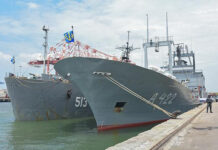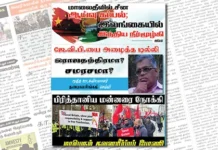Our Neighbourhood First policy had led to increased economic cooperation with Sri Lanka but its economy is in deep trouble and India’s relations with it have taken a turn for the worse this year, Srejita Nandy, economist with India Exim Bank explains in an opinion article published in livemint.com.
India’s ‘Neighbourhood First’ policy towards Sri Lanka had resonated with Sri Lanka’s ‘India First’ foreign and security policy in 2020. India is Sri Lanka’s third largest export destination, after the US and UK. More than 60% of Sri Lanka’s exports enjoy the benefits of the India-Sri Lanka Free Trade Agreement, which came into effect in March 2000. India is also a major investor in Sri Lanka. India’s development partnership with Colombo has always been demand-driven, with projects covering social infrastructure like education, health, housing, access to clean water and sanitation, besides industrial development.
Concessional financing of about $ 2 billion has been provided to Sri Lanka through various Indian government-supported Lines of Credit across sectors (for railway connectivity, infrastructure, supply of defence equipment, security, and counter-terrorism and solar projects, among others). Foreign direct investment (FDI) from India amounted to around $ 1.7 billion over the years from 2005 to 2019 and went into retail petroleum, hotels and tourism, real estate and manufacturing, apart from telecom, banking and financial services.
However, relations between the two neighbours seem to have plummeted since the beginning of this year. In February, Sri Lanka backed out from a tripartite partnership with India and Japan for its East Container Terminal Project at the Colombo Port, citing domestic issues. Later, the West Coast Terminal was offered under a public private partnership arrangement to Adani Ports and Special Economic Zones Ltd.
Last July, the Reserve Bank of India (RBI) had signed a currency-swap agreement with the Central Bank of Sri Lanka (CBSL) under the Saarc Currency Swap Framework 2019-22, for withdrawals of up to $400 million. The CBSL settled the scheduled facility with RBI in February 2021. Even though the agreement was valid till 13 November 2022, India declined any further renewal of it in the absence of an International Monetary Fund programme to address Sri Lanka’s current macroeconomic imbalances.
On 31 August 2021, Sri Lanka declared a state of economic emergency, as it is running out of foreign exchange reserves for essential imports like food. The CBSL was the first Asian central bank to increase policy rates after the covid pandemic in response to rising inflation in August 2021 caused by currency depreciation. Tourism, a big dollar earner for Sri Lanka, has suffered since the Easter Sunday terror attacks of 2019, followed by the pandemic. Earnings fell from $3.6 billion in 2019 to $0.7 billion in 2020, even as FDI inflows halved from $1.2 billion to $670 million over the same period.
Sri Lanka’s fragile liquidity situation has put it at high risk of debt distress. Its public debt-to-GDP ratio was at 109.7% in 2020, and its gross financing needs remain high at 18% of GDP, higher than most of its emerging economy peers. Following an international sovereign bond settlement of $1 billion in July 2021, its gross official reserves slipped to $2.8 billion, which is equivalent to just 1.8 months of imports. The external debt-to-GDP ratio stood at 62% in 2020 and is predominantly owed by its public sector. More than $2.7 billion of foreign currency debt will be due in the next two years.
As of June 2019, China’s loans to the Sri Lankan public sector amounted to 15% of the central government’s external debt, making China the largest bilateral creditor to the country. Unable to service its debt, in 2017, Sri Lanka lost the unviable Hambantota port to China for a 99-year lease. Nevertheless, Sri Lanka has increasingly relied on Chinese credit to address its foreign debt burden. Many loans have been negotiated between Colombo and Chinese institutions, including a recent syndicated loan for budgetary support of $1.3 billion from China Development Bank and a $1.5 billion currency swap pact with the People’s Bank of China this March. China’s exports to Sri Lanka surpassed those of India in 2020 and stood at $3.8 billion (India’s exports were $3.2 billion). Owing to Sri Lanka’s strategic location at the intersection of major shipping routes, China has heavily invested in its infrastructure (estimated at $12 billion between 2006 and 2019). In May, Sri Lanka passed the Colombo Port City Economic Commission Act, which provides for establishing a special economic zone around the port and also a new economic commission, to be funded by China.
Sri Lanka’s economic crisis may further push it to align its policies with Beijing’s interests. This comes at a time when India is already on a diplomatic tightrope with Afghanistan and Myanmar.
Other South Asian nations like Bangladesh, Nepal and the Maldives have also been turning to China to finance large-scale infrastructure projects. Nurturing the Neighbourhood First policy with Sri Lanka will therefore be important for India, albeit with due caution, to preserve its strategic interests in the Indian Ocean region. The Colombo port is crucial for India as it handles 60% of India’s trans-shipment cargo. Regional platforms like the Bay of Bengal Initiative for Multi-Sectoral Technical and Economic Cooperation and the Indian Ocean Rim Association could be leveraged to foster cooperation in common areas of interest like technology-driven agriculture and marine sector development, IT and communication infrastructure, renewable energy, and transport and connectivity. Both countries could also cooperate on enhancing private sector investments to create economic resilience.





